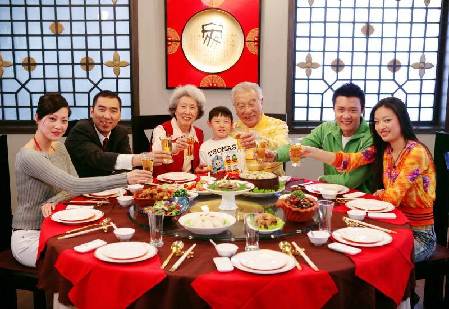
On the night of New Year's Eve, Chinese families come together for a celebration dinner. This custom is also called "surrounding the hearth," from the custom in earlier times of eating dinner around the family hearth. Both children and adults eat together and dinner begins only after all of the family members are present at the table. A table setting is placed for those unable to come home for dinner on this day to symbolize their presence though far away.
As the nuclear family becomes an increasingly scarce phenomenon in modern society, this symbol of unity takes on increasing significance. New Year's Eve dinner is best eaten slowly, savoring the flavor of each dish. Several of the dishes served on this occasion have auspicious meaning and are indispensable to the night's menu: "Long Year Vegetables" (mustard greens) to represent intelligence; "Whole Chicken," symbolizing wealth for the whole family (since "chicken" and "family" rhyme in the Taiwanese dialect Chinese); and fish balls, shrimp balls, and meat balls are eaten to symbolize the three top scores earned during the civil service examination in ancient China and, by extension, success in educational pursuits. The only dish not included in the cornucopia of food eaten on the New Year's Eve dinner table is whole fish, which is intentionally left off the menu so that "there will be more to come in future years" (since the Chinese words for "fish" and "surplus" rhyme).
Some families will also prepare jiaozi, Chinese dumplings stuffed with meats and vegetables. Since the shape of the dumplings resembles a gold ingot, eating jiaozi symbolizes the calling of wealth into one's life, and some go even as far as to stuff real money in the dumplings to insure that the coming year will bring fortune.
Editor: Xu Xinlei
|


